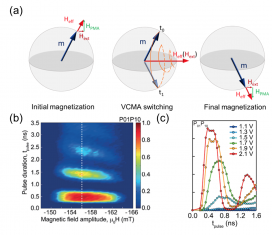Voltage Controlled Magnetic Bits for Extremely Efficient Computer Memory
Researchers at the NSF-funded Engineering Research Center for Translational Applications of Nanoscale Multiferroic Systems (TANMS), headquartered at UCLA, have made significant strides in improving the system efficiency of magnetoresistive random-access memory (MRAM) when compared to existing technologies. Their primary accomplishment lies in the substantial reduction of write energy by two orders of magnitude, with the potential for further reduction by another order of magnitude. This remarkable improvement effectively eliminates the detrimental impact of memory on battery life. In contrast to the state-of-the-art spin-transfer torque technology, which typically requires approximately 100 femtojoules (fJ)/bit for writing energy, TANMS’ demonstrations have showcased an impressive energy efficiency of approximately 1 fJ/bit (two orders of magnitude better) on a 1Kb array, while effectively addressing CMOS integration challenges. Additionally, they have successfully enhanced other critical metrics such as chip capacity, speed (read/write access time), and data retention by implementing efficient circuitry, advanced materials, and innovative device concepts in an integrated manner. This research is revolutionizing the field of MRAM technology by effectively tackling one of its key challenges (energy efficiency) while opening up exciting new approaches for non-von Neumann-type architectures.
TANMS has established strong collaborative relationships with prominent industrial partners, including Western Digital, Inston, and Canon Anelva, in order to bridge the gap between the Center’s theoretical concepts and practical implementation. Through these partnerships, they have made significant progress in integrating their developed MRAM technology onto CMOS chips using the back-end-of-line process, thereby paving the way for large-scale manufacturing. The Center’s primary objective is to replace power-hungry and non-volatile memories such as dynamic and static random-access memories (DRAM and SRAM) with highly efficient MRAM-based memories. By leveraging MRAM, they aim to overcome these limitations and introduce innovative functionalities in future computing paradigms, such as computing-in-memory and neuromorphic computing. Through the collaborative efforts and dedication to cutting-edge research, TANMS is poised to shape the future of memory technology and enable transformative advancements in multiple industries.
The Center’s main focus lies in the exploration and utilization of voltage-controlled magnetic anisotropy (VCMA) as a primary mechanism for writing bits of memory. VCMA is a phenomenon where the magnetic anisotropy of a material can be modified by applying voltage. Magnetic anisotropy refers to the preferred orientation of magnetic moments within a material, determining the state of MRAM as either "up" (1) or "down" (0). VCMA allows researchers to manipulate this anisotropy without relying on external magnetic fields but solely with an applied voltage. This characteristic holds significant importance for advanced low-power, high-speed, and high-density magnetic devices. By applying voltage, they modify the magnetic energy landscape of a bit, enabling them to alter its stability and switch the memory bit from up to down, or vice versa.
The figure presents an illustration of the VCMA MRAM switching mechanism. Figure (a) shows a schematic of dynamic VCMA switching. The applied voltage modifies the magnetic anisotropy, causing the magnetic moment to precess along the effective field direction. After completing half a period of precession, the voltage is turned off, allowing the anisotropy to recover. As a result, the moment stabilizes in the opposite direction. The experimentally measured switching behavior is demonstrated in figure sections (b) and (c). Notably, a clear periodic pattern is observed, indicating the nature of the precession. The speed of switching is sub-nanosecond, limited by the ferromagnetic resonance frequency. Furthermore, the power consumption can be scaled down to sub-femtojoule, depending on the VCMA coefficient and the device size. This represents a significant improvement of more than two orders of magnitude compared to today's electric current-based switching technology, primarily due to reduced ohmic loss. Apart from its application in MRAM, the VCMA device can also serve as a true random number generator and enable stochastic computing.


